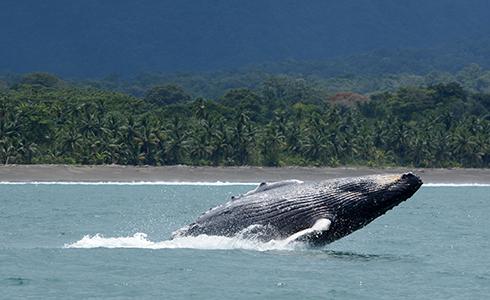Social media video featuring the project.
Remote Biopsy Choco 2015
23 Jul 2015 Coquí, Colombia, Central and Latin America Cetaceans
Diagnosis of the Taxonomic Composition, Spatial Distribution, Social Structure and Conservation Threats of Marine Mammals in Tribugá’s Gulf
Humpback Whales off Tribugá's Gulf, Colombian Pacific, During the Breeding Season
The current project aims to describe understudied aspects of the reproductive ecology and habitat use of humpback whales on a Colombian breeding ground by employing satellite tagging and skin biopsy.

Mother, calf and escort surfacing in close association.
Mother-calf pairs of humpback whales are especially susceptible to anthropogenic impacts due to their preference for shallow, coastal waters. The current project will employ satellite tagging to study the reproductive ecology, habitat use, and population structure of humpback whales in a northern portion of the Colombian Pacific. Tagging allows for prolonged monitoring of an animal’s position, providing information that would not be available on research or whale watching vessels. Essentially, as long as the tags stay attached to the whales, it is possible to know where the whales are going, which leads to the identification of the areas that are important for them and might require special protections and monitoring. If mother and escort are tagged when associating it is also possible to estimate the stability and duration of their association. Tagging will occur in late August-early September, when most calves have been born.

Once a group of mother, calf and escort is located, tags will be implanted only on adult animals using a pneumatic rifle that will be deployed from a distance of approximately 5 m from the whales. Tags will be implanted close to the dorsal fin, which is commonly exposed when whale go to the surface to breath. The signal from the tagging devices will be received through the ARGOS system, commonly used for humpback whales and other marine vertebrates. After tagging, tissue samples will be extracted to define the maternal lineages in the Colombian Pacific. Positions will be used to create distribution maps that allow modelling of the patterns of distribution and habitat use of mother and calf pairs, and escorts, in Tribugá’s Gulf. The Association Coefficients methodology will be employed to evaluate the two hypotheses available to explain the role of an escort whale when joining a mother-calf pair: a protective role vs. a reproductive strategy. This data will provide valuable tools for the management and conservation of the species in Colombia and other regions of the world.
Social media video featuring the project.
Remote Biopsy Choco 2015